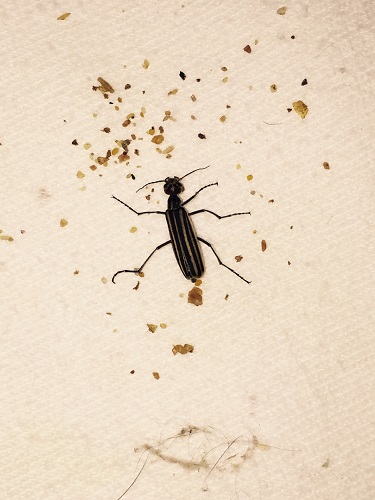Blister Beetle Toxicity in Horses
Blister beetle toxicity: a potential threat to horses eating alfalfa in 2015
Beth Davis, DVM, PhD, DACVIM

|
| Striped blister beetle, 2015 |
A recent situation in North Carolina highlights the importance of being careful when feeding alfalfa hay to horses. Under certain conditions alfalfa hay can become contaminated with blister beetles. When horses ingest blister beetles they can become quite sick, even develop life threatening complications, particularly if veterinary treatment is not provided.
What are blister beetles?
Blister beetles are a type of beetle that secrete an irritating substance called cantharidin. The technical description for blister beetle toxicity is canthanridin intoxication. There are thousands types (species) of blister beetles, so it is impossible for anyone to be familiar with all of them. One of the more common types is the striped blister beetle shown in the photograph. This was a beetle found in the Manhattan, KS area in July 2015.
How do horses get exposed?
There are several developmental stages of blister beetles, the larvae may ingest other insects or even grasshopper eggs, while adult blister beetles may feed on flowers or leaves of plants such as alfalfa, particularly when in substantial bloom (> 20%). Blister beetles often swarm and if they are feeding on alfalfa in the field they may be harvested with the hay in a localized area due to this swarming nature of the insects.
Most commonly beetles are abundant during the mid-summer months, so the second cutting of alfalfa is the stage that is most likely to be consumed by beetles and a potential threat to horses. In general early and later cuttings of hay are less likely to have beetles present. The first and fourth (if the crop permits a fifth cutting this should be okay as well) are considered safer cuttings. It is important that the individual purchasing the hay speak with the farmer regarding the cutting of hay and the method used for harvesting. When the hay is cut and baled at the same time, generally with a crimper, this makes it harder for the beetles to escape the harvesting process. Therefore, it is ideal to purchase alfalfa where a crimper was not used. This means the hay was cut and left to dry then baled at a later time. This staging of the harvest provides the beetles time to escape, making it less likely they will be baled in the hay.
What are the clinical signs?
If a horse consumes blister beetle contaminated hay they often experience irritation (blisters) in their mouth and throughout their gastrointestinal tract. The cantharidin is excreted through the kidneys and is very irritating to the urinary system. Signs of exposure and toxicity include dunking their mouth into the water source, reduced eating, abdominal pain (colic), stretching out to urinate, frequent attempts to urinate and overall lethargic attitude. Signs can vary depending on the number of beetles ingested. Severe toxicity can result in electrolyte changes that cause abdominal cramping called “thumps”. Thumps is a direct result of alteration of electrolyte status and indicates that more severe intoxication has occurred.
If a horse is fed alfalfa hay and displays any of these signs the horse owner should contact their veterinarian immediately. Examination includes evaluation of the horse and collection of blood, toxicity results in serious electrolyte changes that often require correction. Changes can also be observed in the white blood cell count and protein levels.
What can be done to help horses that have had exposure?
Treatment is aimed at reducing further toxin absorption, improving hydration status, correcting electrolyte abnormalities and reducing pain. In most cases hospitalization is required for a few days to possibly a week or more.
It is very important to have any suspect cases examined by a veterinarian. Treatment is important to improve the prognosis for a favorable outcome. Unfortunately, this is a very serious toxicity that can be fatal if not managed properly or if toxicity is severe.
Diagnostic testing can be performed to determine if cantharidin is present in the urine, this is an additional step of evaluation that will aid with management of other horses on the farm and the potential disposition of remaining alfalfa hay.
How can this be prevented?
The best prevention is to avoid feeding alfalfa hay. However, many horse owners recognize that alfalfa is a valuable forage source that is rich in protein and nutrients. Horses that receive alfalfa as a component of their diet should be provided with alfalfa from the first or fourth / fifth cuttings, preferably harvested at < 20% bloom. Horse owners or farm managers should speak directly with the farmer regarding the harvest practices. Most farmers know if there are blister beetles around and can provide an indication if they think there is a chance for contamination. Horse owners can check their hay to see if beetles are present, but it should be noted that blister beetles are very small (approximately 1-2.5 cm in length). A casual or quick observation could miss beetles being present. Depending on the species, a small number of beetles can result in toxicity. It is important that all methods of care and caution are adopted if alfalfa hay is being fed.